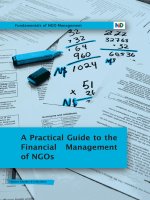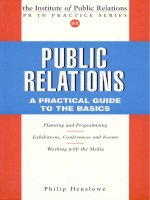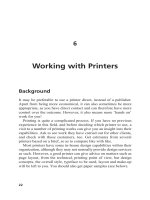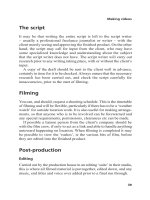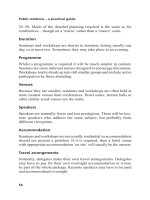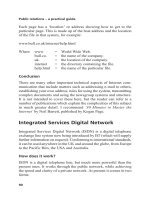Public relations a practical guide to the basics_4 potx
Bạn đang xem bản rút gọn của tài liệu. Xem và tải ngay bản đầy đủ của tài liệu tại đây (157.4 KB, 17 trang )
39
Making videos
The script
It may be that writing the entire script is left to the script writer
usually a professional freelance journalist or writer with the
client merely seeing and approving the finished product. On the other
hand, the script may call for input from the client, who may have
some specialized knowledge and understanding about the subject
that the script writer does not have. The script writer will carry out
research prior to any writing taking place, with or without the clients
input.
A copy of the draft should be sent to the client well in advance,
certainly in time for it to be checked. Always ensure that the necessary
research has been carried out, and check the script carefully for
innaccuracies, prior to the start of filming.
Filming
You can, and should, request a shooting schedule. This is the timetable
of filming and will be flexible, particularly if there has to be a weather
watch for outside location work. It is also useful for making arrange-
ments, so that anyone who is to be involved can be forewarned and
any special requirements, permissions, clearances etc can be made.
If possible a liaison person from the clients company should be
with the film crew, if only to act as a link and able to handle anything
untoward happening on location. When filming is completed it may
be possible to view the rushes, ie the various bits of film, before
they are edited into the finished product.
Post-production
Editing
Carried out by the production house in an editing suite in their studio,
this is where all filmed material is put together, edited down, and any
music, end titles and voice over added prior to a final run through.
319(09).p65 13/06/00, 12:3139
Public relations – a practical guide
40
The client is normally invited to this preview to see the finished
work and to give approval. At this stage, minor alterations can still
be made if necessary.
Packaging the finished product
Depending on what the video has been made for, it may be necessary
to have a special, decorative cover made for the video box, together
with a stick-on label on the cassette itself. These may have to be
specifically designed, either by the studio (with additional cost impli-
cations), or in-house by the client. Alternatively, a simple typed label
may be sufficient if the video is only to be used in house for, say,
training purposes. Whichever way, it needs a bit of thought.
319(09).p65 13/06/00, 12:3140
41
Exhibitions and other events
10
Exhibitions and
Other Events
This chapter covers some of the higher profile work in which public
relations practitioners get involved from time to time. All these areas,
exhibitions, displays and events, generally involve an enormous amount
of planning, attention to detail and above all hard work.
The chapter does not cover working abroad, where planning details
can vary enormously according to the host country, location, type of
exhibition, promotion or trade fair etc. However, the general principles
remain the same. What follows are a number of hints, tips and check-
lists which should be useful to the reader.
Exhibitions and trade fairs
There is always a pubic relations benefit to be gained from exhibitions,
whether they are large or small, an international trade fair, private
view, public exhibition, or even a local carnival or fête.
Remember the difference between a trade show and an exhibition
exhibitions are open to the public, trade shows are normally restricted
to the trade. There are exceptions to this rule, however, with major
events such as the Motor Show and the Boat Show which, although
primarily aimed at business, are also open to the public.
319(10).p65 13/06/00, 12:3241
Public relations – a practical guide
42
Characteristics
Large exhibitions and trade fairs have the same general characteristics.
They take place at well-known venues, eg Olympia, Earls Court or
the NEC. They have large, often very sophisticated, stands and dis-
plays. They usually last between three and five days (sometimes even
longer), take months of preparation and, while they can be exciting
and fun (especially if in some exotic location abroad!) are usually
exhausting work for all concerned.
Above all else, there is the opportunity at exhibitions and trade
fairs to meet your publics and get to know them, so that when you
contact them afterwards you are not just a voice at the other end of a
telephone, but a person with whom they have had personal contact.
The different types of work
From the public relations practitioners point of view, there are four
aspects of involvement in exhibition work. They are:
1. public relations support at an exhibition stand;
2. setting up and running a stand at an exhibition;
3. organizing an exhibition;
4. public relations exhibitions or displays.
Support at the stand
The value of any exhibition is enhanced by taking full advantage of
any public relations opportunities that can be created. These oppor-
tunities must never be neglected or overlooked. If you have been
commissioned, either as the PR department in an organization which
is exhibiting, or by your client as a consultancy, to give public relations
support on the stand, there are some basic rules to remember.
Before the event takes place, you need to have some details, such
as:
l The organization exhibiting is it part of a larger group or con-
glomerate, or is it an independent exhibitor?
319(10).p65 13/06/00, 12:3242
43
Exhibitions and other events
l What are they exhibiting what is on show?
l Are there any special or unusual features about either the stand
or any of the exhibits?
l What handouts or free gifts are available, what special promotional
activities etc are scheduled to take place?
Armed with this information, there are a number of activities that
have to be carried out when planning, before, during and after the
exhibition. These are given in detail in Appendix 5, and include
matters such as making contact with the exhibition press office, finding
out who is opening the exhibition, getting details about the press day
and much more.
Setting up and running your own stand
When you are responsible for a stand at an exhibition, care must be
taken not only in the planning prior to the event, but also in the staffing
and in the implementation. After all, you are presenting, or even selling,
a professional service on the stand, so why do so in an amateurish way?
Bad planning and slipshod operating of an exhibition stand is bad
public relations, and the organization being represented on the stand
will not be seen to best advantage. An exhibition stand is intended to
show off the organization it represents. It should not only look profes-
sional, but also be professional in the way it is run. If it is, then it will
not only serve to enhance the organizations reputation, but also your
own.
Before the event
Good planning is essential for success. If you intend to exhibit, then
some key questions need to be answered first, such as:
l What is the purpose of the exhibition?
l Why are we going?
l What sort of image is to be displayed?
l How is it to be achieved?
l What is the budget for it?
319(10).p65 13/06/00, 12:3243
Public relations – a practical guide
44
Assuming that you get satisfactory answers to these questions and
are going ahead, you now book the necessary exhibition space.
Booking space
This is done through exhibition organizers, or contractors. These are
specialist firms, expert and experienced in this kind of work. Bookings
are taken in advance, normally six months to a year ahead, depending
on the event. Trade fairs are often booked a year or more in advance.
Early booking should ensure that you get a stand where you can be
seen, not one in some dark, out-of-the-way corner. Make sure you
are happy with the position of the stand.
On booking, a percentage of the fee is payable up front as a deposit.
This may or may not be refundable in the event of cancellation
always check the small print of the contract. The balance of the fee is
payable after the event.
What sort of space?
When booking stand space, exhibition organizers will usually offer a
choice, either basic stand space or, more expensively, a shell stand.
Stand space is simply that you have to produce the stand within
the constraints of the space booked. Shell stands, on the other hand,
come complete with walls, usually of hardboard or similar material,
a standard facia board over the front with your organizations name
and stand number, some sort of flooring, a ceiling and basic lighting.
Make sure the correct details are on the facia.
The rest, as they say, is down to you.
Contractors’ manual
Details of the exhibition venue, including specifications of the shell
stand construction, height and other restrictions, should all be con-
tained in the contractors manual. This indispensable document should
be sent to you on confirmation of booking space. If it isnt, insist on
getting one soonest.
The manual should contain a wealth of detailed information. It tells
you what you can and cannot do on the stand, and what additional
services are available for hire such as furnishings, floral decorations,
319(10).p65 13/06/00, 12:3244
45
Exhibitions and other events
stand cleaning etc. Handy booking forms are enclosed at the back.
However, do remember that all these attractive optional extras will
cost you! So, if you are working to a tight budget, take your own, or
borrow where possible.
The unions
At many exhibition venues the unions involved may have an agree-
ment with the venue management that only qualified persons may
put up and take down the stands. Specific rules on this may be laid
down and if so, should be in the manual. Check it out. (The author
speaks from bitter personal experience having, unintentionally, nearly
caused a 24-hour strike at the Brighton Metropole Exhibition Centre
by using a screwdriver to fix a light on his stand!)
Unions
319(10).p65 13/06/00, 12:3245
Public relations – a practical guide
46
Planning the stand
In planning what the stand will look like you can choose either to do
your own thing by using existing material, designing your own stand
with visual displays, photographs, models, or whatever else you wish.
Or you can go the whole hog - if you can afford it and hire a designer
to do it for you.
Exhibition designers
Exhibition designers will design, transport, erect and dismantle the
stand to your specific needs. A good exhibition designer can save
you money and many hours work. It may well be more cost efficient
to use one, thus allowing you to arrive at the venue fresh and eager to
go, knowing that your stand will have been set up for you and that at
the end you can walk away from it.
Some designers also provide a range of other services, including
special graphics, finishes, logos, photographic panels and much more.
They are not cheap, but will work within your budget limits. Basically,
you will get what you can afford.
They are professionally qualified and experienced and will be
familiar with the venue and any constraints there may be. They also
carry the right union cards (see above).
During the exhibition
You should arrive at the venue at least the day before, and carry out
the checks relevant to you that are given in Appendix 5.
Press kits and exhibition publications
Press kits
It is not always necessary to produce lavish press kits packed with
non-news items. The press will be selective and will only take what
they feel they can use. Dont overwhelm them with bits and pieces.
Remember, there will be hundreds of stands, all providing their own
information. Make sure, however, that the press office is kept topped
up with the relevant topical information, handouts, photos etc from
your stand. Visiting once or twice a day to check will be helpful.
319(10).p65 13/06/00, 12:3246
47
Exhibitions and other events
They will get to recognize and know you good public relations for
you!
Exhibition newsletters
During a big exhibition there is normally an exhibition newsletter
published. There might only be one edition, but may be two or three
depending on the duration of the exhibition. They will want contribu-
tions from you. If not, offer some anyway.
News and events
There is usually a daily bulletin issued by the exhibition press office
for the exhibitors convenience. Normally on two sides of A4, it
simply gives the events of the current or following day, any special
events, visits, or other exhibition news. It is usually circulated to all
stands every morning prior to opening up, or the evening before. You
may want to get something into it for your own stand. If so, make
sure you know when it is required and by whom.
Good housekeeping
Stand cleaning
Exhibition stands can get quite grubby, both from your own staff and
from visitors and the rubbish they leave behind. There will be your
own litter to be removed, ashtrays to be emptied, plastic cups etc dis-
posed of, and the whole stand generally freshened up on a daily basis.
Do you really want to vacuum up all those crumbs on the floor
after that reception, remove those coffee stains and polish up the stand
furniture? You can if you want to. If so, you will need to have the
necessary cleaning equipment with you which either has to be stored
at the back of the stand or brought in every day. Or you can hire a
cleaning service that will do all these chores, which not only saves
your time but your energy too. This service is normally advertised
in the contractors manual and can be booked prior to the event.
Floral decorations
The same also applies to any flowers, foliage etc on the stand. They
can be booked in advance and will be delivered complete in their
containers to your stand and removed at the end. Or you can provide
your own.
319(10).p65 13/06/00, 12:3247
Public relations – a practical guide
48
Furniture
You can either bring your own, or hire it on site. There are many
firms specializing in hiring furniture for stands. They offer a wide
range, from chairs and tables to ashtrays, wastepaper baskets and the
like.
Afterwards
Dont forget the evaluation or wash up. It will be your benchmark
for future similar events. Look at both the good and bad points. Work
out what could be done differently or better, for next time.
Organizing an exhibition
What happens when the public relations department has to organize,
and then run, an exhibition itself? How is it done? Many of the actions
required are similar to those given in the section above, but with some
major differences. The department (you) becomes responsible for all
of the following:
l booking the venue;
l arrangements for all publicity and promotion;
l inviting potential exhibitors to participate;
l providing the contractors manual;
l arranging the exhibition hall layout and the provision of stand
space, services etc;
l manning a press office and providing information services.
Contractors
Much, if not all of the detailed provision and planning needed to set
up an exhibition can be dealt with by employing an exhibition con-
tracting firm. Using such a contractor is very often the best, most
cost-effective and professional way to organize an exhibition. They
have professionally trained staff, experienced in all aspects of exhibi-
tion work. Using one will enable the PR department to coordinate all
319(10).p65 13/06/00, 12:3248
49
Exhibitions and other events
the detailed planning and also make the best use of its own resources,
both in terms of time and money.
Used extensively by organizations and trade associations in the UK,
they set up and then run professional trade and public exhibitions,
both in this country and abroad. They can solve all your problems for
you at a stroke. However, they do not come cheap.
The contractor’s brief
As there will be very large amounts of money involved, if using such
a firm, or firms, ensure that they are always given a clear, compre-
hensive brief and that the subsequent written agreement contains all
the detail.
Conclusion
Exhibitions are a very good, and often cost effective, way of promoting
an organizations image creatively. They are an excellent way of
communicating at first hand with clients, the public and the media,
and can show off the exhibitor and whatever products and services
are being displayed to the best advantage.
But, because they are also expensive, the reasons for being at a
trade fair or exhibiting at some major spectacular events must be
carefully considered beforehand, and the expense justified. Some
serious decisions have also to be taken as to what messages and images
are to be put across, and how to do this within the allocated budget.
As with all public relations work, attention to detail is very important
in order to ensure success.
The first event is always the worst with experience it gets a lot
easier!
319(10).p65 13/06/00, 12:3249
Public relations – a practical guide
50
11
Promotions and Functions
Promotions and functions cover a wide spectrum of events, from
seminars, conferences and annual general meetings to press launches.
The management of functions and promotions is an area of public
relations work that has grown more sophisticated, and more com-
plicated, during the last decade. As with exhibitions and displays,
successful management of promotions and functions generally can
be a most effective public relations tool, and one that is becoming
more frequently used.
Inevitably, there will be examples of bad planning, slipshod manage-
ment and execution on the organizational side. Overall, however, the
trend in this area of our work is positive, with an increasing number
of better managed, often more sophisticated events, and an increased
professionalism in the approach to this aspect of public relations work.
Venues
The choice of venues for functions such as promotions, product
launches, conferences and the like is now very varied. In recent years
there has been a boom in the building of convention centres all over
the country. Many cities and towns have central sites with multi-
purpose properties, built for the staging of events. They range from
319(11).p65 13/06/00, 12:3250
51
Promotions and functions
the vast Queen Elizabeth Conference Centre and the Wembley
Conference Centre in London, the International Convention Centre
in Birmingham, to The Hawth in Crawley and Woburn Abbey in
Bedfordshire. Many smaller cities and large towns have converted or
newly built properties on central sites for this purpose.
Most decent-sized hotels have purpose-built conference centres and
facilities, catering for often quite large events. Even some theatres in
London are now promoting their facilities for business entertainment,
conferences and product launches. Universities, college campuses,
public schools, castles, country houses, racecourses and football
stadiums are all gearing up to become venues for conferences and
special events throughout the year and are all touting for business.
When choosing a venue, therefore, a number of considerations need
to be taken into account. You need to ask yourself the following
questions before making a final decision:
l Is the venue appropriate to the event?
l Is it accessible and convenient to get to?
l Is it big enough?
l Does it have enough accommodation?
l Is it the right sort of accommodation?
l What other facilities are there, either at the venue or adjacent to
it?
The programme
Any event or function, whatever shape it may take, must have a
programme; without one, it is impossible to manage successfully. Also,
without a programme, even a simple one, delegates and others attend-
ing the event will be confused and frustrated and the objectives of
the event will not be achieved, resulting in your appearing unprofes-
sional. Some programmes will, by the nature of the event, be formal;
others less so.
(Examples of programmes for different categories of events together
with their main characteristics are given in Appendix 2 at the end of
this Chapter)
319(11).p65 13/06/00, 12:3251
Public relations – a practical guide
52
The characteristics and categories of
events
Annual meetings
Venues will vary, ranging from hotels or public halls to major exhibi-
tion halls or conference sites. All should be easily accessible for
members and/or shareholders.
Annual meetings will normally be in a formal setting and have a
formal agenda, at least for part of the meeting. The adoption of the
previous minutes, chairmans address, presentation and adoption of
the annual accounts and the appointment of auditors, non-executive
directors etc are all items that form the basis of the programme, or
agenda, for such meetings.
The amount of prior notice required and the methods to be used to
summon an annual general meeting are usually laid down, either
within the constitution of the organization or by the terms of a com-
panys legal requirements. Whatever they are they must be strictly
adhered to or the meeting could be invalid or declared unconstitutional.
Conferences
Conferences are a good method of direct communication, with many
opportunities for good public relations. Below are some hints and
guidelines on organizing them, from the public relations point of view
(see also Appendix 8).
General characteristics
Conferences normally cover a variety of topics with a common theme.
They are a combination of the spoken word (plenary sessions, work-
shops and fringe activities), audio-visual displays and presentations,
the written word (eg papers delivered), displays and, sometimes,
small trade exhibitions. They tend to be rather impersonal, set in a
large hall or theatre, with a platform for the set-piece sessions and
speeches.
319(11).p65 13/06/00, 12:3252
53
Promotions and functions
Conferences can be very sophisticated (eg party political confer-
ences), lasting five days and including side shows (eg fringe meetings,
talks and receptions) as satellites to the main sessions. Or they can
be simple, one-day affairs with a number of set speakers and only
plenary or full, formal sessions.
Numbers
Conferences are usually fairly large gatherings. Numbers of delegates
can vary from perhaps 150 at the bottom of the scale to several
thousand at the top end. The average attendance is usually around
the 350450 mark.
Dates and seasons
Most major conferences tend to be held in the autumn September
through to late October or early November are favourite months.
Academic conferences and those held at universities, however, will
usually take place during the long summer vacation. This may change
in future as some universities are considering scrapping the long
vacation and having more semesters in order to become more cost
effective.
Duration
Conferences usually last between two and four days, but can some-
times be held for only one day. Weekend conferences are often more
favoured by academics and some of the voluntary organizations, while
political and major business conferences are usually held during the
week and can last up to six days.
Accommodation
Conferences are usually residential and often require a considerable
amount of accommodation for delegates. This should be borne in mind
when deciding on the venue availability of hotels and guest houses
may be a key factor.
If held at a university, student halls of residence are often used.
They are cheaper than hotel accommodation and more plentiful but
319(11).p65 13/06/00, 12:3253
Public relations – a practical guide
54
much more basic! You must know what kind of accommodation will
be expected by your delegates.
Fees and expenses
Delegates to conferences normally pay a fee which may include some
extras, but meals, travel and even certain accommodation may not be
included in the fee. Guest speakers normally have their travel expenses
paid in addition to their fee, unless they waive it. This can all be quite
expensive, especially if the keynote speaker lives in Australia!
Travel arrangements
Travel arrangements for conferences need careful planning, partic-
ularly for delegates who may not have visited this country before.
Most overseas delegates will travel by air, but there may well be rail
travel involved as well, for which the conference organizers will be
responsible.
Air travel
Special arrangements may have to be made at airports to greet dele-
gates on arrival and dispatch them with onward travel arrangements.
If the conference venue is abroad, sometimes a particular airline,
usually the flag carrier of the host country (eg QANTAS for
Australia, will offer special reduced rates for delegates but only
with that carrier. It is worth checking with the airline).
Rail travel
Some railway companies may offer a conference service, with
specially reduced rates for delegates rail tickets within the UK. Check
with the appropriate companies to confirm whether this service is
available.
Sponsorship
You may be lucky and get a major sponsor for the whole conference.
They will, of course, normally expect their name to appear in bright
lights during the conference, and may lay down certain other condi-
tions. Sponsorship can be enormously helpful and, if you are going
to get it, you should obviously liaise with the sponsors PR department.
319(11).p65 13/06/00, 12:3254
55
Promotions and functions
The speakers
First-class keynote speakers are essential for the major, plenary sessions.
They will enhance the programme and help to attract delegates.
Keynote speakers must be chosen with care. Ideally, they should
not only be well known but should also have expert knowledge of
their subject. They should also be good public speakers. Nothing is
worse than having a keynote speaker who, while an expert in the
chosen field, is an abysmal speaker. Take advice if necessary.
Presentation equipment
The standard of visual aids and sound equipment can make all the
difference between a good conference and a mediocre one. Presenta-
tions should ideally be a combination of audio-visual and speech, with
well-produced handouts. Make sure, therefore, that there are sufficient
visual aids available of good quality, plus back-up for emergencies!
Find out what equipment the speaker intends to use. Have sufficient
spare items available such as slide cartridges and carousels for speakers
(who may bring their own slides), overhead projection equipment and
other visual aid equipment. Check that all the PA and CCTV systems
you intend to use are online. Check and double check.
Social programmes
Most conferences will have some kind of a social programme as part
of the conference proceedings. These can range from a reception on
the first evening, to a series of parties, a full-blown dinner with
speeches, an awards presentation, tours and visits, and sometimes a
separate programme for delegates partners. This might be a day trip
to a local tourist attraction, a shopping trip or a mini programme
lasting for one or two days.
Seminars and workshops
These are usually much smaller gatherings than conferences, with
normally only a single topic. Numbers are usually not more than
319(11).p65 13/06/00, 12:3255
